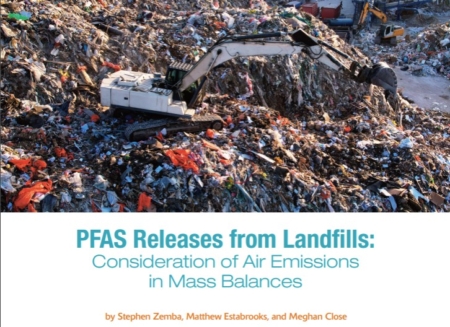Sanborn Head, University of Guelph / Morwick G360 Groundwater Research Institute, HDR, and Pace® Develop Technique for Investigating and Analyzing PFAS in Bedrock
Bedrock presents a challenge for investigators looking to analyze the presence of PFAS and other contaminants. In fractured rock with a secondary (fracture) porosity of as little as 0.01 to 0.1% and a primary (intergranular) porosity of as much as 10-15%, most of the contaminant mass may be found in the immobile groundwater in the primary intergranular porosity or rock matrix as dissolved and sorbed phase rather than the bedrock fractures. Previous trichloroethylene (TCE) studies have shown that a significant mass of contaminants can diffuse into the groundwater in the rock matrix where it resides as dissolved and sorbed phase, providing a continual source of contamination to the bedrock fractures through back diffusion if fracture concentrations decline due to natural source depletion or engineered remediation activities. Similar studies have shown that over 90 percent of the TCE contaminant mass can be stored in the rock matrix, leading to the under-characterization of groundwater contamination and ineffective remedial design and remedial action.
To overcome this challenge, the team of Sanborn, Head & Associates, Inc., University of Guelph / Morwick G360 (MG360), HDR, and Pace® built on the long history of using COREDFN to investigate and analyze chlorinated solvents in bedrock by adapting this approach for PFAS contamination at an industrial site in the northeastern United States where PFAS contaminants had migrated to the underlying bedrock.
Background
HDR, a U.S.-based professional services firm, was tasked by the EPA in 2022 to investigate the property that had been the home of a former upholstery manufacturing facility. Previous investigations focused on chlorinated solvents, including TCE. These solvents penetrated into bedrock groundwater via fractures and subsequently diffused into the groundwater stored within the inter granular sedimentary bedrock within the source area and plume that formed downgradient. HDR called on Sanborn Head, a licensed practitioner of COREDFN, the University of Guelph, and Pace® to support its efforts to characterize the contamination at this site.
“COREDFN was initially designed to assess the distribution of chlorinated volatile organic compounds in fractured bedrock environments, with focus on quantifying the occurrence of these chemicals in the bedrock matrix,” explained Jessica Bulova, Project Director at Sanborn Head. “In these fractured bedrock environments, contaminant mass diffuses into the matrix, resulting in long-term contaminant storage, which can result in back diffusion of contamination for decades. In recent years, we have been working to include additional volatile and semi-volatile organic compounds, metals contamination such as hexavalent chromium, as well as emerging contaminants such as PFAS.”
HDR was tasked to extend the bedrock investigation to include per- and polyfluoroalkyl substances (PFAS), as the manufacturer historically used PFAS-based products to treat fabrics. Pace® worked with this team to adapt the techniques used to analyze bedrock for TCE so that they could also quantify PFAS in bedrock samples, specifically PFOA and PFOS.
“We had already partnered with Pace® for the COREDFN VOC testing,” said Brad Green, Senior Vice President at Sanborn Head. “Based on this experience working with Pace® and its experience with PFAS analysis, we were excited to collaborate with them and researchers from the Morwick G360 Group to advance the science of PFAS analysis in bedrock.”
Challenges
COREDFN was developed to analyze volatile compounds in bedrock. To fulfill the client’s request, the team needed to answer a twofold question. Could the COREDFN sampling process be used to extract bedrock samples suitable for PFAS analysis? If so, what sample preparation and extraction methods and which analytical test methods would provide the most accurate and reliable results?
“We knew some aspects of analyzing for PFAS in bedrock would be easier since it isn’t a volatile compound,” said Nick Nigro, Pace® PFAS Product Manager. “However, we suspected the method used to pulverize the core samples wouldn’t be sufficient. If you just take a chunk of rock and put it in a methanol extraction solvent, you’re only going to measure what’s primarily on and close to the surface and extraction times for highly sorbed contaminants would be long. If there’s PFAS diffused in that solid material, it will not be adequately reflected in your results.”
Analyzing for VOCs in bedrock also uses microwave assisted extraction (MAE) to enhance extraction of the VOCs from the crushed samples. “You can’t do that for PFAS because you’re likely to have thermal transformation or decomposition,” added Nigro. “Microwaving also has the potential to convert any PFAS precursors into terminal PFAS.”
Solution
The team determined that no technical changes needed to be made to the core drilling and collection process or the way the samples were collected from the intact rock cores, but certain precautions were taken to avoid cross-contamination of samples or unintentional introduction of PFAS through the standard sampling procedures. “We altered a few standard operating procedures to avoid unintentionally introducing PFAS into the sample” said Bulova. “For example, we typically line the core tray with foil and wrap samples in it as well. But since foil may contain trace amounts of PFAS, we eliminated it from the process. We also eliminated the O-rings from the stainless-steel equipment used for crushing samples in the field.”
Next, experts from Pace®, Sanborn Head, MG360, and HDR determined how to best process samples and extract the PFAS to ensure accurate results. Nigro and his team had plenty of experience using cryomilling to prepare other solids, such as consumer goods, for PFAS analysis. Pace® validated the process using the first 30 core samples shipped from the site. These samples were split into two fractions and went through a formal comparison study to evaluate the optimal extraction and analytical techniques. One set was processed using a conventional extraction approach similar to the process Pace® uses for “normal” soil and other solids but with a built-in time series extraction. The second set of samples was prepared using a cryogenic milling technique in hopes of expediting the extraction process to remove PFAS from the bedrock matrix.
The results of this comparison validated that the cryogenic milling preparation method resulted in a higher extraction efficacy and thus higher PFAS concentrations indicative of more complete extraction. The primary reason for this was that cryogenic milling pulverized the bedrock sample into a fine-grained (100-400 micron), homogenous material, facilitating more effective extraction of PFAS from the bedrock matrix samples, which is a more reliable and robust estimate of PFAS mass in bedrock as compared to the long timeframe extraction approach.
Results
This collaborative study demonstrates the exciting and successful adaptation and modification of the COREDFN approach for application to sites with PFAS contamination in bedrock. In aggregate, the approach provides a defensible method to understanding PFAS distribution in the bedrock matrix, which will be critical to the development of sound conceptual site models for PFAS occurrence, transport, and fate at fractured bedrock sites. Going forward, Pace® will continue to partner with Sanborn Head and MG360 to apply COREDFN principals to bedrock sites where PFAS are a contaminant of concern.
Acknowledgements
Pace® would like to thank the many individuals and organizations that helped bring COREDFN to market and for allowing us to leverage our expertise to advance the science of PFAS testing and analysis. Special thanks to leaders from these organizations for their commitment to the project and its goals:
- Dr. Beth Parker, University of Guelph / Morwick G360 Groundwater Research Institute
- Bradley Green, Senior Vice President, Sanborn, Head & Associates, Inc.
- Daniel St. Germain, Senior Technical Leader, HDR
- Nicholas Nigro, PFAS Product Manager, Pace®
- Dr. Tadeusz Górecki, University of Waterloo
Posted In: Articles
Tagged In: Industrial, PFAS, Research






